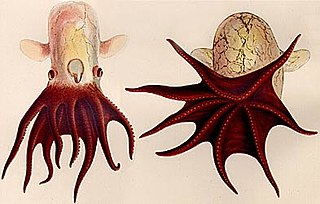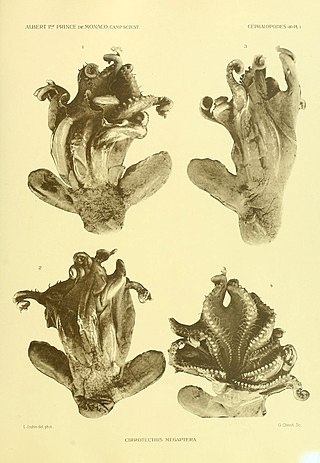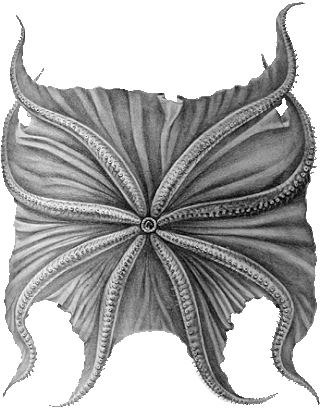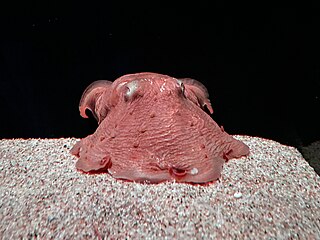
Velodona togata is a species of octopus in the monotypic genus Velodona. First described by Carl Chun in 1915, with a second subspecies discovered by Guy Coburn Robson in 1924, it was named for the distinctive membranes on its arms.

Grimpoteuthis bathynectes is a deepwater species of Grimpoteuthis (Dumbo) octopus first described in 1990. It is known from 13 specimens.
Grimpoteuthis abyssicola, commonly known as the red jellyhead, is a species of small deep-sea octopus known from two specimens. The holotype specimen was a female collected on the Lord Howe Rise, between 3154 and 3180 meters depth. A second specimen was collected on the continental slope of south-eastern Australia between 2821 and 2687 m depth.
Grimpoteuthis boylei is a species of octopus known from only ten individuals.
Grimpoteuthis challengeri is a species of large octopus living in the abyssal zone.

Grimpoteuthis discoveryi is a small species of octopus known from more than 50 specimens. It was described in 2003, but specimens have been found as early as 1910. The type species was found at 49°35'N, 14°01'W.

Grimpoteuthis hippocrepium is a species of octopus. It is only known from one specimen found in 1904, which was poorly preserved. Some characteristics G. hippocrepium are unknown.
Grimpoteuthis innominata, commonly known as the small jellyhead, is a species of small, pelagic octopus described by Steve O'Shea in 1999 from two specimens, however several further specimens have since been identified. The genus Enigmateuthis was described to contain this species when described, but Martin Collins placed the species in the genus Grimpoteuthis due to uncertainty regarding the type specimen of Grimpoteuthis.

Grimpoteuthis meangensis is known from either one or two specimens, though the second may be of a completely different species. The first was damaged. Both were found by William Evans Hoyle within one year of each other, and no other animals of the species have been identified since 1886.

Grimpoteuthis megaptera is a species of octopus known from five specimens, collected by Addison Emery Verrill. Between two and three of these specimens may belong to different species.

Grimpoteuthis pacifica is an octopus known from one badly damaged specimen. It is not completely described, and it is not easily separated from some other species of octopus. Nothing clearly differentiates G. pacifica from Grimpoteuthis hippocrepium except for its type locality.

Grimpoteuthis plena is known from only one specimen, which cannot be easily separated from other species of Grimpoteuthis in the Atlantic Ocean. The specimen was in poor condition. It's similar to Grimpoteuthis wuelkeri, and may be a junior specimen of Grimpoteuthis umbellata.

Grimpoteuthis umbellata, known from three specimens, is the type species of Grimpoteuthis.
Grimpoteuthis wuelkeri is a medium-sized octopus characterized from multiple specimens.

Opisthoteuthis agassizii is a lesser-known, deep-sea octopus first described in 1883 by Addison E. Verrill.
Opisthoteuthis bruuni is a species of finned cirrate octopus found along the western coast of South America. Their tissue is almost jelly-like, and they have short, round bodies.

Opisthoteuthis depressa, also known as the Japanese flapjack octopus, is an octopus found in waters near Japan.

Opisthoteuthis grimaldii is an octopus found near the Azores.
Opisthoteuthis massyae is an octopus living in the eastern Atlantic Ocean.
Opisthoteuthis persephone is a cirrate octopus living south of Australia. In particular, it lives in waters off Tasmania, Victoria, New South Wales, and South Australia. The octopus has been found 270–540 m (885.8–1,771.7 ft) deep. It lives near and directly above the seafloor. S. Stillman Berry was the first to scientifically describe this species after capturing eight specimens while aboard the F.I.S. Endeavour in the early 1910s. In describing O. persephone, Berry called it an "exceedingly interesting octopod".












